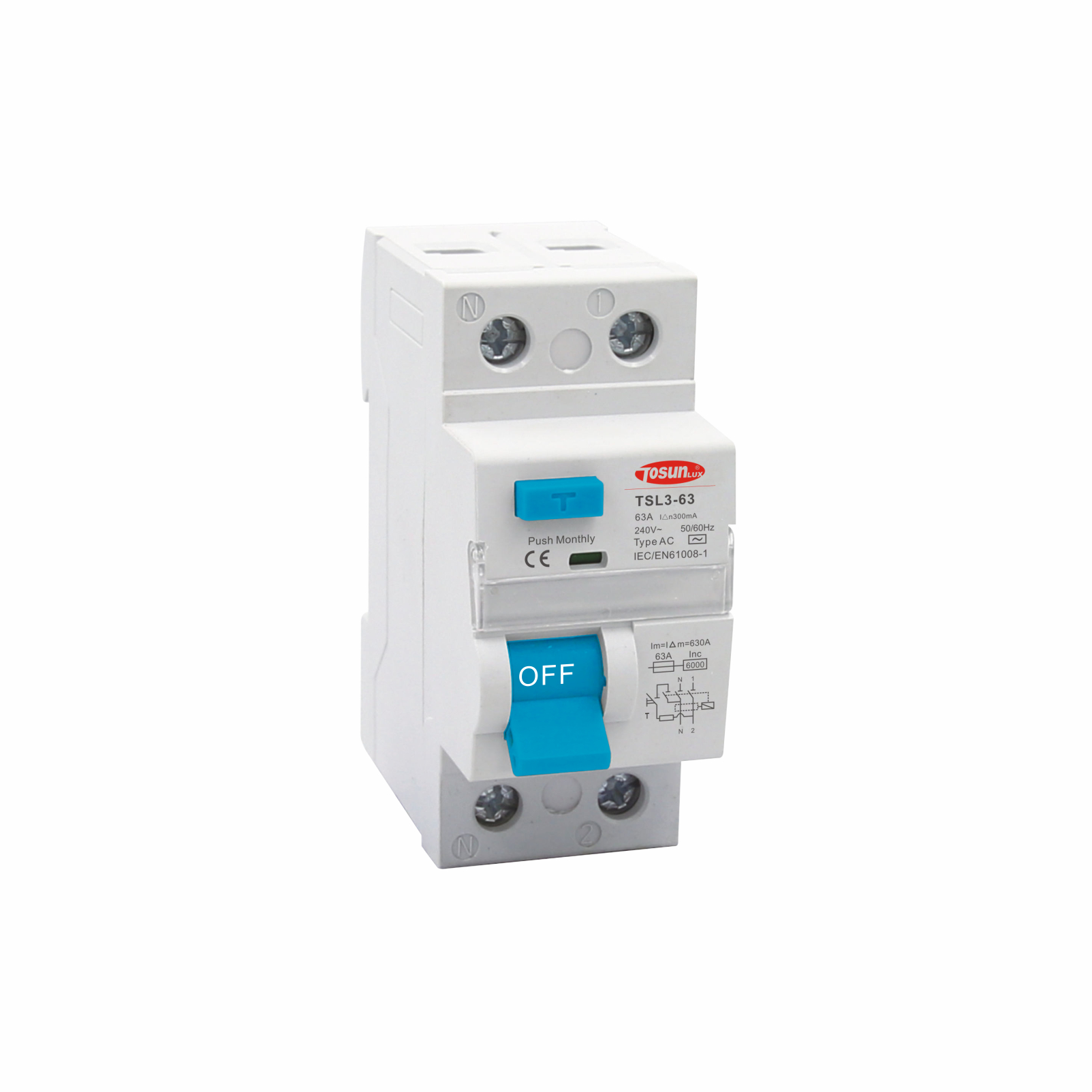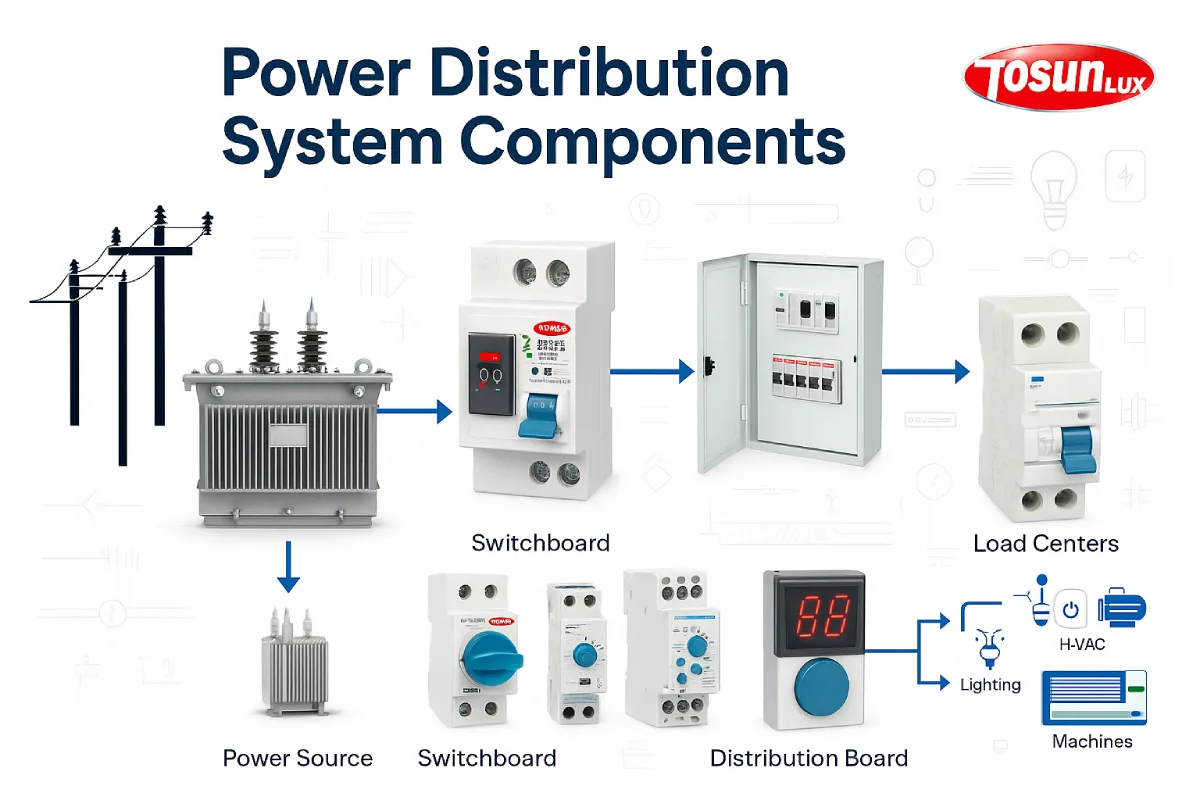The Must-Know Standards: Why Type B RCCBs are Essential for Specific Industrial Applications
Daftar isi
BeralihType B RCCBs are essential because they detect smooth DC fault currents that standard devices cannot see. When power electronics create DC leakage, Type AC and Type A RCCBs get blinded and fail to trip.5 Type B units use specialized detection technology that works across all fault current types.6
What is a Type B RCCB?
A Type B RCCB is a pemutus arus sisa that detects AC, pulsating DC, and smooth DC fault currents. Type AC devices only detect alternating currents.7 Type A devices handle AC and pulsating DC.8 Type B is the only option that detects smooth DC currents from power electronics.
Type B RCCBs use flux-gate detection technology instead of the standard core transformer design.9 This technology prevents magnetic saturation that blinds other RCCB types. The device maintains sensitivity across all fault current waveforms including high-frequency AC components and smooth DC currents.10
Comparing RCCB Types
| RCCB Type | Detects AC Currents | Detects Pulsating DC | Detects Smooth DC | Aplikasi Umum |
|---|---|---|---|---|
| Type AC | Ya | TIDAK | TIDAK | Basic lighting, standard outlets |
| Type A | Ya | Ya | TIDAK | Residential appliances, computers, LED lights |
| Type B | Ya | Ya | Ya | VFDs, EV charging, solar systems, industrial equipment |
The RCCB Type A vs Type B difference comes down to smooth DC fault detection.
Why Standard RCCBs Fail with Power Electronics
Standard RCCBs use a core transformer that monitors current balance between live and neutral wires.11 Normal operation keeps these currents equal with no net magnetic field. Faults create imbalances that generate a magnetic field in the transformer core.12 When the field reaches a threshold level, it triggers the trip mechanism.
Smooth DC current creates a constant magnetic field in the transformer core rather than an alternating one. This constant field pushes the core toward magnetic saturation. Once saturated, the core cannot detect AC fault currents that should trigger a trip. The RCCB stays closed even during dangerous faults.
Type B RCCBs solve this with flux-gate detection circuits.13 These circuits use separate sensing elements that measure magnetic flux without saturation issues. The device detects smooth DC currents while maintaining full sensitivity to AC and pulsating DC faults.14
Industrial Applications Requiring Type B RCCBs
Modern industrial equipment uses power electronics that produce smooth DC fault currents.15 Only Type B RCCBs can detect these currents reliably. Here are the applications where this protection is essential:
- Variable Frequency Drives: VFDs control motor speed in pumps, cranes, conveyors, elevators, and HVAC systems.16 Power converters generate smooth DC leakage during faults that standard RCCBs cannot detect.
- Electric Vehicle Charging Stations: EV chargers transfer DC power to batteries and create DC leakage currents during fault conditions.17 Most electrical codes now mandate Type B protection for these installations.
- Sistem Tenaga Surya: Solar panels generate DC power that inverters convert to AC.18 System faults produce smooth DC leakage. Solar installations operate for decades with minimal supervision, making reliable fault detection critical.
- Industrial Machinery: CNC machines, automated production lines, robotics, and industrial control systems use power electronics for precision control. Equipment with rectifiers or voltage converters generates smooth DC leakage during faults.

Type B RCCB (TSL3-63)
- Smooth DC Fault Current Detection
- Protects VFDs, EV Chargers, Solar Systems
- Flux-Gate Technology (Prevents Saturation)
- IEC 61008 Certified Personnel Safety
IEC Standards and Compliance Requirements
IEC 61008 defines performance requirements and testing procedures for RCCBs.19 Type B devices must meet additional requirements for smooth DC detection. The standard specifies test procedures using smooth DC currents up to 6mA to verify detection capability.
The standard defines rated residual operating currents for different protection levels. 30mA sensitivity provides personnel protection against electric shock. 100mA and 300mA ratings protect against equipment damage and fire risks.20
Applications requiring Type B RCCBs according to IEC standards:
- Power electronic equipment installations
- Sistem energi terbarukan
- EV charging infrastructure
- Industrial automation systems
Many countries base national electrical codes on IEC standards.21 Type B protection becomes legally required for specific applications where codes adopt these standards. Check applicable standards before selecting protection devices to ensure compliance.
Selecting the Right Supplier
When evaluating a B Type RCCB supplier, look for certifications, product availability, and technical support capabilities.
Key factors to evaluate:
- Sertifikasi: IEC/EN 61008 compliance is baseline. Look for CE, CB, and TÜV marks that show independent testing verification.
- Product range: Complete RCCB lines simplify sourcing when you need multiple protection types across different circuits.
- Technical support: Application engineers help verify correct device selection for complex systems where safety and code compliance matter.
- Manufacturing quality: Direct manufacturers with established facilities deliver consistent performance across device lifespan.
Need a Reliable One-Stop Supplier for Panel Components?
Source your certified accessories, control devices, and protective equipment from one single, trusted brand.
TOSUNlux Type B RCCB Solutions
TOSUNlux has manufactured low-voltage electrical protection devices for over 30 years.22 Our RCCB product line meets IEC/EN 61008 standards with CE, CB, and TÜV certifications.
Product specifications:
- Voltage ratings: 230V/400V systems
- Sensitivity options: 30mA, 100mA, 300mA
- Pole configurations: 2-pole and 4-pole
- Breaking capacity: 6000A
- Network frequency: 50/60Hz
We manufacture at our Wenzhou facility with quality control from design through production. Our product line includes both Type A and Type B devices for industrial power distribution and renewable energy applications.
Browse our Type A and Type B RCCBs for industrial applications
Ringkasan
Type B RCCBs detect smooth DC fault currents that blind standard protection devices.23 The key difference is flux-gate detection technology that prevents magnetic saturation. Standard Type AC and Type A devices use core transformers that saturate when exposed to DC currents.
Industrial applications with power electronics require Type B protection. VFDs, EV chargers, solar systems, and industrial machinery all produce smooth DC fault currents. IEC 61008 defines Type B requirements and specifies applications where this protection level is necessary.
Telp: +86-577-88671000
E-mail: ceo@tosun.com
Skype: tosunelektrik
Telepon: +86-139 6881 9286
WhatsApp: +86-139 0587 7291
Alamat: Kamar No.1001 Wenzhou Fortune Center, Station Road, Wenzhou, Tiongkok
PERMINTAAN PENAWARAN
WhatsApp kami
 : +86-139 0587 7291
: +86-139 0587 7291 Bahasa inggris
Bahasa inggris Bahasa Spanyol
Bahasa Spanyol Rusia
Rusia Perancis
Perancis العربية
العربية Portugis Brasil
Portugis Brasil Ukraina
Ukraina Bahasa Turki
Bahasa Turki Bahasa Polandia
Bahasa Polandia Belanda
Belanda Bahasa Italia
Bahasa Italia Bahasa Indonesia
Bahasa Indonesia Bahasa Hindi
Bahasa Hindi اردو
اردو 08:00
08:00 Tambah
Tambah Tidak ada
Tidak ada Mongol
Mongol Bahasa Inggris
Bahasa Inggris Bahasa Inggris Shqip
Bahasa Inggris Shqip Yunani
Yunani


